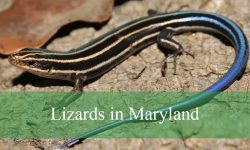Some living things mimic others for food and protection reasons. Mimicking makes the organisms involved deceive their predators or get food with ease. Do not be surprised when you encounter spiders that look like scorpions.
Scorpions are distant cousins of spiders and both have eight legs. Some spiders have long tails that resemble scorpions. We wrote this article to share descriptions and pictures of spiders that resemble spiders.
Are Spiders That Look Like Scorpions Poisonous?
A scorpion-tailed spider is harmless and non-venomous to humans. These cool-looking spiders rarely bite since they spend most of their time hiding from their potential predators.
But if they happen to bite, the victim will experience localized pain and swelling. Besides that, these spiders do not attack with their tails which do not contain venom.
When these scorpion-like spiders are disturbed, they will curl up their tails. The timid trait is the reason behind their harmless behavior.
If you have allergy problems, you might experience skin itching from scorpion-like spider bites. We recommend seeking immediate medical assistance from a professional doctor.
Spiders That Look Like Scorpions (With Pictures)
Scorpions are scary creepy creatures since their tails contain venom. The tail is ideal for protecting and suppressing prey by injecting venom. But Scorpion-like spiders are harmless and non-venomous to humans. Here is a list of spiders that look like scorpions:
Tailed Forest Spider
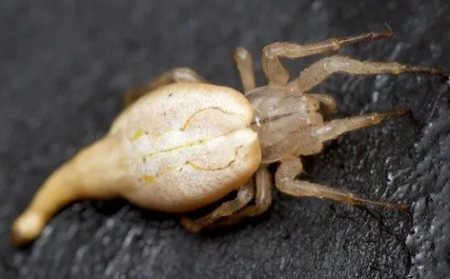
The tailed forest spider belongs to the Arachnura family and hails from Australia and New Zealand. Female spiders have tails that they wiggle when disturbed.
Male species are smaller than their female counterparts and they are rarely seen. They spend their time hiding from predators and waiting for prey before ambushing them.
Black Tail Spider
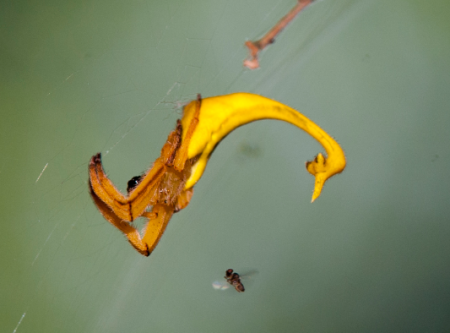
Blacktail spiders are native to India and Japan. These scorpion-like spiders can mimic dead leaves, fallen flowers, and twigs.
The camouflage behavior helps them hide from potential predators and ambush their prey. They are often seen in highland farms and secondary forests.
Eremorhax Magnus
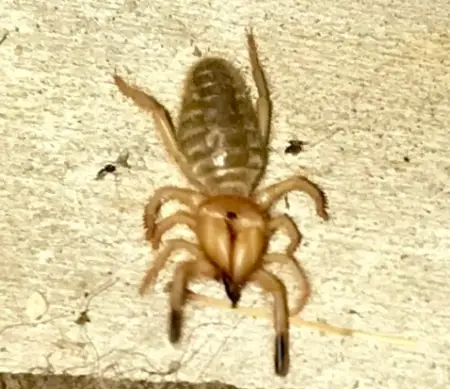
These creepy crawling creatures belong to the wind scorpion spiders group. They are highly distributed throughout the United States from Texas to Mexico.
They are nocturnal and often seen at night searching for food. They prefer living in the desert or semi-desert habitats in deep caves.
Eremobates Pallipes
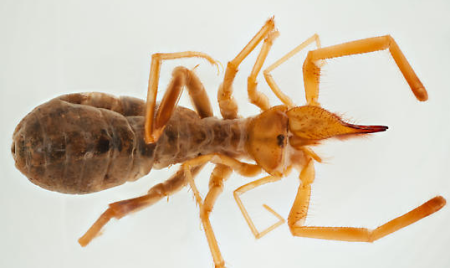
These wind scorpion spiders are common in Arizona and Canada due to their variable climatic habitats. The dry climate creates a favorable environment for their multiplication.
These scorpion-like spiders use rocks and bushes for shade in desert areas. Females are larger than males in size and length.
Eremobates pallipes have yellow to brown bodies divided into three parts. The cylindrical abdomen has been divided into ten segments with three pairs of legs.
Indopadilla insularis

Indopadilla insularis is a spider species with a close resemblance to scorpion and it is endemic to India. The scorpion mimicry spider has a flat and broad carapace for easy identification.
The tube-like abdomen looks like the tail of a scorpion with enlarged front legs. The front leg’s protrusion resembles the pincers of a scorpion.
Eremobates Palpisetulosus
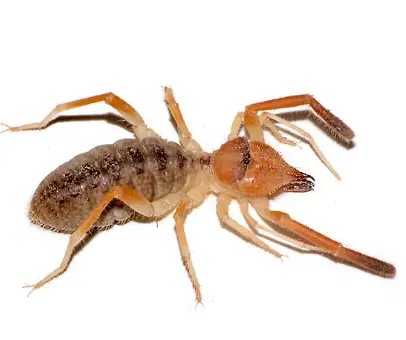
This spider species belongs to the Eremobatidae family and it is highly distributed in North America. These scorpion-like spiders can bite humans or pets if disturbed in their territories.
The females have opercula separated with pits halfway along the ectal edges. Males have straight cheliceral fingers with a ridge near the base.
Paraphrynus Carolynae

The scorpion-like appearance makes these spiders look scary though harmless if not disturbed. They release vinegar-like foul that causes skin irritation and blistering.
The claw-like pincers can grow up to 85mm long and they do not bite humans. The first pair of legs are used as sensory organs with the remaining six used for walking.
The head pate has one pair of eyes on the front and three pairs on either side. These creepy creatures live under the stones and tree barks.
Florida Tailless Whipscorpion

These spiders that resemble scorpions are common in Florida, the Bahamas, Cuba, and Hispaniola. They are nocturnal and rarely seen.
They can grow up to 18mm long with front legs measuring about 100mm. The front legs are used as sensory organs while the other six legs are for walking.
The three pairs of legs allow these spiders to move faster and sideways. The Florida tailless whip scorpions use pedipalps to capture their prey.
Phrynus Operculatus
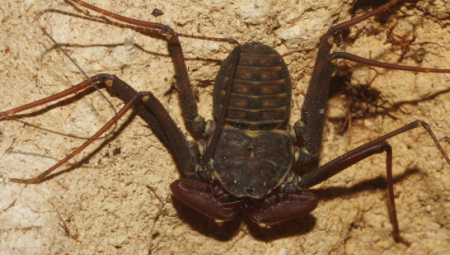
These scorpion-like spiders are endemic to the United States of America. They are highly distributed in Texas and Mexico.
They love living under tree bark, in forests, in dry cacti, and under rocks or stones. They can grow up to 22mm long with chestnut to red color and a narrow front area.
House Pseudoscorpion

The spider species mimic the scorpion morphologically and behaviorally. But the scorpion-like spider is harmless to humans and pets.
The robust front pair of legs is dark that almost resembles the stark of scorpions. The claw-like legs have a sharp appearance and the other pairs are light brown.
These jumping spiders have abdomens with central markings with brown over the lighter. The thorax has a dual tone for easy identification.
Garypus californicus
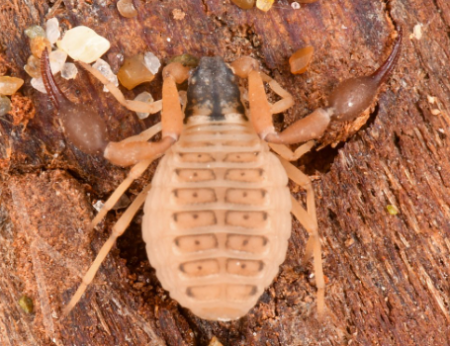
These spider species belong to the Garypidae family and are harmless to humans. But the menacing appearance can be intimidating since they resemble scorpions.
The front legs are large and mimic the claws of the scorpion. The robust front legs are ideal for suppressing the prey before injecting them with venom.
The head and thorax are dark with shades of brown color. The creamy-white abdomen has dark brown lines on the top for easy identification.
Pseudogarypus Bicornis

These scorpion-like spiders are native to the United States of America. They are often seen in Arizona California, Colorado, Utah, Oregon, Wyoming, and Washington.
The females grow up to 3.25mm long while their male counterparts are about 2.96mm. The female scorpion-like spiders are longer than their male species.
Hentz Jumping Spider
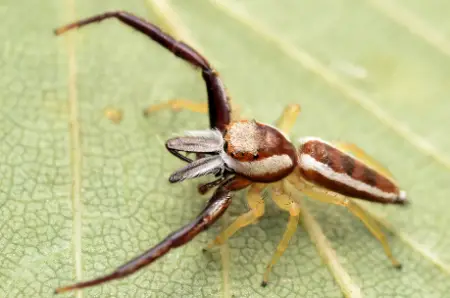
It is a tiny spider species that belongs to the Salticidae family. The jumping spider is quite huge and usually appears scary or dangerous.
Hentz jumping spiders ambush their prey and do not weave webs. The front legs are large and longer than the other pairs of legs.
The front powerful legs help in bringing the prey under control before biting them to inject the venom. The abdomen has subtle dark lines and cephalothorax with dark and white colorations.
Dwarf Florida Jumping Spider

Dwarf Florida jumping spider is another scorpion-like species native to the United States of America. It is often seen in Arizona, Florida, Texas, Louisiana, and Mississippi states.
The front leg pairs are enlarged to resemble a scorpion and the rest are brown. The head and thorax are black with white markings on the margins.
The long abdomen with front legs mimicking the scorpion is the reason behind the spider species classification. It can be dangerous to humans or pets when threatened.
Stagetillus Opaciceps
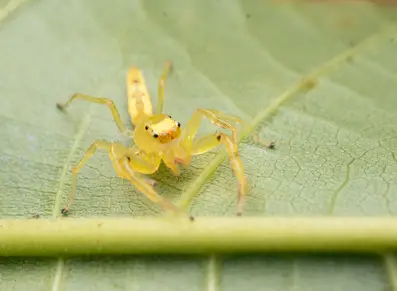
The southeast jumping spider species has a yellowish-red body with dark side stripes on the carapace for easy identification. The scorpion-like spider is native to Malaysia and Indonesia.
The slender and elongated abdomen with dark purple and long white marks on the edges and a transverse white mark closed to the spinnerets are other distinctive features.
The front leg pairs are robust and mimic the claws of scorpions. All other legs are yellow except the front pair for easy identification.
My Final Thought
Most spiders that look like scorpions are harmless to humans despite their menacing appearance and behavior. Some are tiny and nocturnal making them quite rare to be seen.
Scorpion mimicry spiders with tails do not sting and are medically not important. We hope this guide will help you identify scorpion mimicry spiders in your home or garden.
People Who Read This Also Read:





